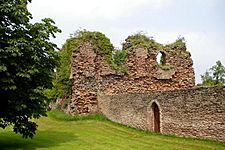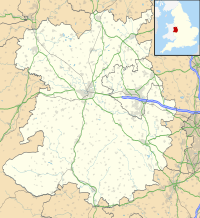Alberbury Castle facts for kids
Quick facts for kids Alberbury Castle |
|
|---|---|
| Alberbury, Shropshire, England | |

Alberbury Castle
|
|
| Coordinates | 52°43′24″N 2°57′07″W / 52.7234°N 2.9520°W |
| Site information | |
| Condition | Ruined |
| Site history | |
| Materials | Stone |
Alberbury Castle is an old ruined castle in the village of Alberbury. This village is in Shropshire, England, very close to the border with Wales. The castle was built using local red sandstone. Today, it is a "Grade II listed building," which means it's an important historical site.
Contents
History of Alberbury Castle
The exact start of Alberbury Castle is not fully known. It was likely built in the 1200s by a person named Fulk FitzWarin. This was during the time when King Richard I ruled England.
Why the Castle Was Built
The main reason for building Alberbury Castle was to protect the area. It helped to stop attacks from Wales. It also helped control the important paths along the River Severn.
Attacks and Rebuilding
Records show that Llywelyn the Great, a powerful Welsh leader, destroyed the castle in 1223. But it was rebuilt just three years later, in 1226. This time, a strong stone wall was added around the castle's main area, called the bailey.
A few years later, there was a disagreement over the castle. The Sheriff of Shropshire, Thomas Corbet, tried to take the castle from Fulk FitzWarin. But FitzWarin was able to get his lands and the castle back through legal means.
Later Years of the Castle
The FitzWarin family kept the castle for a long time. However, they later moved their main home to Whittington Castle. Alberbury Castle might have been left empty around the mid-1300s.
The Abbey Next Door
Right next to the castle, there is an old abbey. An abbey is a building where monks or nuns used to live. This abbey has a tall tower with a triangular roof. This tower might have been used as a lookout point for the castle.
The FitzWarin family also started this abbey. It was home to Benedictines from France. They were sometimes called "White Monks" because their religion was known as "Albus Monasterium," meaning "White Monastery."
Who Owned the Castle?
Over the years, Alberbury Castle has had many different owners. In 1842, the castle ruins were owned by Sir Baldwin Leighton. Today, you cannot visit the castle because it is on private land.


